Papers by Mustapha Abubakar
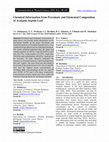
Communication in Physical Sciences, 2010
Proximate and elemental compositions of plant leaves can provide useful information on the nutrit... more Proximate and elemental compositions of plant leaves can provide useful information on the nutritional benefits of the plant. Proximate and elemental analysis of Acalypha hispida leaves were conducted using official and recommended methods. The result obtained indicated that the plant leaf contain moisture (11.02%), crude fat (6.05%), total ash (10.17%), crude protein (13.17%), crude fibre (10.36%) and carbohydrate (48.65%). Analysis for the presence of some elements indicated the presence of essential elements, which included iron, zinc and copper. The toxic lead was also found to be present in the plant leaves as Fe, Zn, Cu and Pb. Iron had the highest mean concentration of 20.7mg/g while concentrations of Zn, Cu, and Pb were 0.230, 0.778 and 1.729 mg/g respectively. Concentration of these metal ions were within the tolerance and safe limits for the human nutrition.
This study was carried out with the purpose of determining which benthic invertebrate fauna are a... more This study was carried out with the purpose of determining which benthic invertebrate fauna are associated with aquatic macrophytes in Nguru Lake. Water and sediment samples were collected over a twelve month period between May 2006 and April 2007.The samples were analysed using standard methods. Seven species of benthic macroinvertebrates belonging to classes Mollusca, Insecta, Annelida and Nematoda were recorded. Distribution of the various physico-chemical parameters was also determined. The density of benthic community recorded from stations infested by aquatic macrophytes particularly Typha sp. are significantly less than those recorded from stations with no or sparse aquatic macrophytes (p<0.01). This benthic macroinvertebrate community observed in the present study was different from that found in Nguru Lake in 1997. And the diversity of taxa was also generally low.
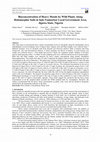
Journal of Natural Sciences Research, 2016
This study aims at assessing the heavy metals concentration levels in wild plants along the holom... more This study aims at assessing the heavy metals concentration levels in wild plants along the holomorphic soil in Suletankarkar Local Government Area of Jigawa State, Nigeria. Soil and Plant samples were collected from 7 different locations. Two (2) locations each from Danaldi and Danzomo districts while a location each from Dangwanki, Jeke and Suletankarkar districts. A 20cm 2 quadrant was thrown at random. At each location, soil sample was collected from 0 – 10cm depth and mixed to obtain one composite sample. Samples of all plant species found growing within 1 m radius of each sampling point were collected and preserved in pressed paper. Both Soil and Plant samples were analyzed for heavy metals concentration using Atomic Absorption Spectrophotometer. The results show that; Cd with 3.6 ppm has the highest while Zn with 0.28 ppm has the least concentration in the soil at Danzomo I. The plants have varying concentrations ranging from Pd with 0.04 ppm to Zn with 5.42 ppm in Mitracarpu...
Assessment of toxicity of treated textile effluents from one of the Textile industry in Kano (Nig... more Assessment of toxicity of treated textile effluents from one of the Textile industry in Kano (Nigeria) was made by acute toxicity test using fish for 96 hours. Analysis of physicochemical parameters revealed that the effluent quality conformed to the statutory limits set by Environmental Regulatory Agency. There was not much variation in the weight of the fish exposed to different treated textile effluent concentrations. There was no significant variation in the length of the fish exposed to different treated effluent concentration. There were no deaths of fish after 96 hours. It is recommended that regular laboratory bioassay is necessary for effluent quality assessment.
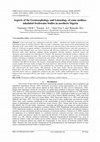
International Journal of Basic and Applied Sciences, 2013
A three-year study was conducted in twenty five molluscinhabited water bodies spread across four ... more A three-year study was conducted in twenty five molluscinhabited water bodies spread across four hydrological areas in northern Nigeria. This was done to determine some aspects of the geomorphology and limnology of the water bodies. Four sampling stations were selected along a line transect across each water body for collection of aquatic molluscs, measurement of physico-chemical factors and other parameters. A portable Combo Hanna® meter was used to measure pH, electrical conductivity, water temperature and total dissolved solids while alkalinity, sulphate, nitrate, phosphate, chloride, hardness, dissolved oxygen and biological oxygen demand were determined by titration. The specimens of freshwater molluscs collected were identified using standard procedure. The result of the study showed that a total of 14 species of freshwater molluscs belonging to 9 families were found in the water bodies. The linear regression analysis showed positive relationships between elevation and temperature, alkalinity, chloride and nitrate, indicating corresponding variations with different elevations. The negative relationship between altitude and pH, hardness and dissolved oxygen signifies that water bodies at higher elevations had lower values for these environmental variables. The Canonical Correspondence Analysis (CCA) established the relationships amongst the environmental factors that characterised the water bodies. The substrata of the water bodies showed heterogeneity. Water temperature, pH, dissolved oxygen, alkalinity, hardness, phosphate phosphorus and sulphate were the likely important factors that are significantly related in the water bodies within hydrological areas. The intense human activity associated with the water bodies could also have negative impact on the aquatic ecology of the study area.
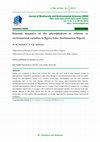
Studies were conducted in Nguru Lake between May 2006 and April 2008 to map temporal changes in p... more Studies were conducted in Nguru Lake between May 2006 and April 2008 to map temporal changes in phytoplankton composition and attempt to relate these changes to environmental parameters in this ecosystem. Twenty five phytoplankton genera were recorded. Green algae (Chlorophyta) were the most dominant contributing 46 % of the total biomass followed by blue green algae-Cyanophyta(29%), diatoms-Bacillariophyta(22%) and finally the Dinophyta(2%). Seasonal changes were observed for the three major plant nutrients total phosphorus (PO4-P) ranged from 5.2-9.6mg/l. Total nitrogen (NO3-N) ranged from 2.4-12.8mg/l and sulphates ranged from 1.0-10.1mg/l. wide variations in environmental variables were observed in the lake. Results obtained in this study showed that the lake was undergoing gradual eutrophication resulting in deterioration of water quality, The eutrophication was further aggravated by increasing human and livestock population.
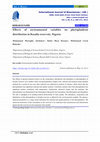
International Journal of Biosciences (IJB)
The effects of physico-chemical factors on the composition, distribution and abundance of phytopl... more The effects of physico-chemical factors on the composition, distribution and abundance of phytoplankton of Kusalla reservoir were studied. Water and phytoplankton samples were collected and analysed using standard methods for a period of one year. Data collected was subjected to analysis of variance, which shows that the phytoplankton has significant seasonal and spatial variation. Correlation analysis show that phytoplankton has significant positive correlation with temperature, conductivity, dissolved oxygen and the nutrients. The phytoplankton was dominated by the Chlorophyta followed by the Cyanophyta. Baccillariophyta and Dinophyta. The lake is adjudged to be tending towards deterioration of water quality. The abundance, composition and distribution of the phytoplankton in Kusalla reservoir is affected by the environmental variables. The physicochemical parameters to a large extent determine the seasonal and spatial patterns of the phytoplankton. The numerical dominance of the Cyanophyta in the reservoir is an indication that autochtonous and allochtonous inputs into the reservoir are decreasing the water quality.
The Association between benthic invertebrates and aquatic macrophytes in a tropical lake, Nguru L... more The Association between benthic invertebrates and aquatic macrophytes in a tropical lake, Nguru Lake: a preliminary survey
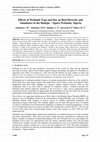
International Journal of Research, 2015
Bird diversity and abundance at the Hadejia – Nguru Wetlands, Nigeria was studied within an eleve... more Bird diversity and abundance at the Hadejia – Nguru Wetlands, Nigeria was studied within an eleven week period in 2011 to determine the effects of wetlands size and type. Thirty two wetlands within the Hadejia – Nguru Wetlands complex were surveyed. The study involved recording birds at predefined wetlands within the HadejiaNguru wetlands complex. Point counts were used to survey birds. Bird count was from 06:30h to 11:00h in the morning and 16:00h to 18:00h in the evening. Data collected was explored for normality and Shannon-Wiener index was used to determine the diversity. Bird diversity and abundance determined by counting birds was related to wetlands size and type. A total of 110,162 of 119 bird species were recorded. Bird species richness and diversity varied across wetland types: Marshes had the highest number of bird species compare to Ponds and lakes whereas bird diversity was significantly higher in ponds than lakes but was similar to the diversity of marshes. Wetlands si...
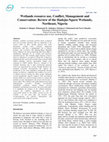
Globally, wetlands ecosystems perform many ecological and socio-economic functions that are benef... more Globally, wetlands ecosystems perform many ecological and socio-economic functions that are beneficial to the society. Some of these include nutrient and waste absorption, ground water recharge, supporting biodiversity, and have a fundamental role in fishing, farming, and recreation. The Hadejia-Nguru Wetlands being a Ramsar site and an Important Bird Area (IBA) is significantly important for its resident and migratory waterbird species. The wetlands supply fisheries resource which is estimated to accounts for about 6% of Nigeria’s inland freshwater catch with a market value of nearly US$6 million annually, whereas agricultural outputs been estimated at US$75 million. However, changed in the wetlands hydrology due to dam construction upstream which was aggravated by extreme drought threatens the wetlands ecosystem. Consequently, this impacts the livelihoods of the local population downstream through changes in land use, competition and conflicts over access to natural resources amon...
Bayero Journal of Pure and Applied Sciences, 2013
The impact of emergent macrophytes on the catch of fish in Nguru Lake was studied from May 2006 t... more The impact of emergent macrophytes on the catch of fish in Nguru Lake was studied from May 2006 to April 2007.Physico-chemical properties of the lake were studied in conjunction with the macrophytes. Experimental fishing was carried out in portions of the lake infested with the macrophytes and portions not infested.data collected were subjected to Student,s t-test. There was significant difference between fish catch in the two portions.. The infestation of macrophytes particularly Typha sp. leads to poor fish yield. The study recommended that farmers should be enlightened on the use of organic fertilizers and other safe farming practices and that further research should be carried out on the proliferation of Typha.
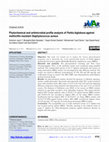
Journal of Advanced Veterinary and Animal Research
Objective: The study was carried out to analyze the various phytochemical properties and to deter... more Objective: The study was carried out to analyze the various phytochemical properties and to determine the in-vitro antimicrobial activity of Parkia biglobosa methanolic leaf extract against Methicillin-Resistant Staphylococcus aureus (MRSA). Materials and methods: The phytochemical screening and Thin Layer Chromatography (TLC) of the methanol extract were conducted using standard methods. The antimicrobial activity of the P. biglobosa methanolic leaf extract on sheep and human MRSA isolates was investigated by disc diffusion method. The extract was tested at different concentrations of 100, 200 and 400 mg/mL and norfloxacin (10 µg) as control. The MIC/MBC were determined by serial dilution method in broth media. Results: the phytochemical analysis showed the presence of alkaloid, saponins, tannins, cardiac glycosides, flavonoids and terpenoids while TLC result revealed 5 spots with retention factor (Rf) values of 0.14, 0.34, 0.42, 0.56 and 0.66 depicting different component using methanol and chloroform at the ratio of 4:1 as solvent system. The diameter of inhibition zone (DIZ) of the extract on MRSA isolates cultured on agar plate revealed a dose dependent response. The extract had the highest DIZ average replicate value of 20.66±1.76 against human MRSA isolates and 20.66±1.20 was recorded as highest DIZ on the sheep MRSA isolates. Norfloxacin had the highest DIZ of 20.33±0.57 on sheep MRSA isolates and 20.33±1.52 DIZ against human isolates. MIC/MBC revealed the highest values of 6.25 mg/mL/12.5 mg/mL for both sheep and human MRSA isolates. Conclusion: The susceptibility test of crude methanol extract of P. biglobosa leaf has revealed activity against MRSA. Thereby, attesting to the folkloric claim of using P. biglobosa for ethno-therapeutic purposes against infectious diseases in Nigeria and other places.
ABSTRACTCirculating tumor DNA (ctDNA) sequencing studies could provide novel insights into the mo... more ABSTRACTCirculating tumor DNA (ctDNA) sequencing studies could provide novel insights into the molecular pathology of cancer in sub-Saharan Africa. ctDNA was readily detected in 15 blood samples collected in Ghana at the time of suspected breast cancer. Genomic alterations previously associated with unfavorable prognostic outcomes were observed in the majority of patients. This supports the use of liquid biopsies for diagnosis, surveillance and clinical management of breast cancer in Ghana.
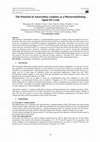
Journal of Environment and Earth Science, 2014
The potential of Amaranthus caudatus as a phytoremediating agent was studied, using lead spiked s... more The potential of Amaranthus caudatus as a phytoremediating agent was studied, using lead spiked soil to grow the plants. The effect of the concentration of lead on plant growth was studied. The main aim of the study was to assess the accumulation of lead (Pb) in different compartments of the plant. The plants were grown in soils treated with solutions corresponding to 25, 50, 75 and 100 ppm of Pb. The plants were than separated into roots, stems and leaves and dried at 60 0 C in a convection oven for 48 hours.The metals from the plant were extracted using wet digestion process. Pearson's coefficient correlation analysis was used to measure the relationship between Pb concentration in the soil and in plant tissues. The highest concentration was recorded in the roots of plants at 50 ppm concentration. A. Caudatus plants exposed to 25 ppm of Pb showed highest increase in root and stem growth. The lowest root growth was observed in plants exposed to 100 ppm of Pb. There is a negative relationship between the concentration of Pb in the soil and that in the above ground plant tissues.
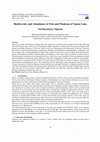
Journal of Biology Agriculture and Healthcare, 2013
Aspects of ecology and fisheries of Nguru lake were studied for a period of twelve months between... more Aspects of ecology and fisheries of Nguru lake were studied for a period of twelve months between May 2006 and April 2007.Nguru Lake, which is part of the Hadejia hectares and depth of between 1.5m to 8m. There is scarcity of information on the biodiversity of the lake .Therefore this work was aimed at determining the composition, abundance and distribution of phytoplankton, zooplankto fish of Nguru Lake. The phytoplankton of Nguru lake consists of twenty five species of algae from four divisions, namely Chlorophyta,Cyanophyta, Bacillariophyta and Dinophyta. Some algae such as Zygnema sp, Microcystis sp, Chlorella sp and Anabaena sp occur throughout the year, while others occur seasonally. All the phytoplankton studied showed significant seasonal and spatial variation (P<0.05).The zooplankton of Nguru lake is made up of four groups, Cladocera (41%), Copepoda (24%), Rotifera (27%) a and Keratella sp dominating the fauna. The zooplankton showed significant seasonal and spatial variation (P<0.05). Twenty four species of fishes belonging to thirteen families were recorded.Th with 64%.The families Claridae and Osteoglossidae constituted 6% each, while the family Malapteruridae was the least with only 0.17%.The mean weight of fish caught per day was 540.17kg, from three landing sites, with fishermen operating averagely from each site.
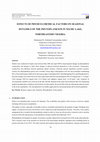
Journal of Natural Sciences Research, 2012
Studies were conducted in Nguru Lake between May 2006 and April 2008 to map temporal changes in p... more Studies were conducted in Nguru Lake between May 2006 and April 2008 to map temporal changes in phytoplankton composition and attempt to relate these changes to physico-chemical parameters in the ecosystem. Temperature, conductivity and alkalinity showed significant spatial variation. Nutrients showed significant seasonal variation. Twenty five phytoplankton genera were recorded. Green algae (Chlorophyta) were the most dominant contributing 46% of the total biomass followed by blue green algae-Cyanophyta(29%), Bacillariophyta(22%) and Dinophyta(2%). Seasonal changes were observed for the three major plant nutrients total phosphorus (PO 4-P) ranged from 5.2-9.6mg/l. Total nitrogen (NO 3-N) ranged from 2.4-12.8mg/l and sulphates ranged from 1.0-10.1mg/l. wide variations in environmental variables were observed in the lake. Results obtained in this study showed that the lake was undergoing gradual eutrophication resulting in deterioration of water quality, decreased fish yield and subsequent reduced income to the local communities. The eutrophication was further aggravated by increasing human and livestock population.
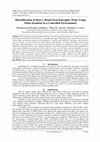
IOSR Journal of Environmental Science, Toxicology and Food Technology, 2014
The remediation of waters polluted with heavy metals using Pistia stratiotes was studied with the... more The remediation of waters polluted with heavy metals using Pistia stratiotes was studied with the aim of assessing the potential of P.stratiotes as a rhizofiltration agent. Wild plants of P. stratiotes were grown in various high concentration solutions of Chromium(Cr), Lead(Pb) and Nickel(Ni). The plants were allowed to grow for twenty one days before harvesting. Metal concentrations were then determined using Atomic Absorption Spectrophotometry. The data generated from the analysis was subjected to analysis of variance (ANOVA) to determine if there is any significant difference between the treatments and the rate of multiplication of the plants. Different concentrations of the metals that were over 300 times what is obtainable in normal plants were observed. The uptake of Ni by P. stratiotes is higher than the uptake of other metals in this study. The uptake of metals was greater in the 2000 ppm treatment than in the other treatments. The plant is able to tolerate the high concentration of heavy metals without showing any visible symptoms. It is also capable of growing past and reproducing within the shortest possible time. P. stratiotes is an excellent candidate for rhizofiltration of heavy metal from polluted waters.
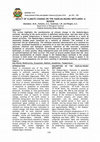
This review highlights the manifestation of climate change in the Hadejia-Nguru wetlands. Warming... more This review highlights the manifestation of climate change in the Hadejia-Nguru wetlands. Warming of the earth surface is definitely taking place. And that most of the increase in global temperature is caused by greenhouse gases emitted as a result of human activities. The Hadejia-Nguru wetland ecosystem comprises permanent lakes and seasonally flooded pools connected by a network of channels. The wetland is an important site for biodiversity. The minimum essential characteristics of a wetland are recurrent, sustained inundation or saturation at or near the surface and the presence of physical, chemical and biological features reflective of the recurrent, sustained inundation or saturation. Functions of wetlands can be grouped broadly as habitat, hydrologic, or water quality. Many endangered plant and animal species are dependent on wetland habitats for their survival. The result of several studies shows that the most obvious manifestation of climate change in the Hadejia-Nguru wetlands is the steady increase in both water and atmospheric temperature. Climate change is global in its causes but its consequences are far more reaching in developing countries, particularly Nigeria.

Uploads
Papers by Mustapha Abubakar